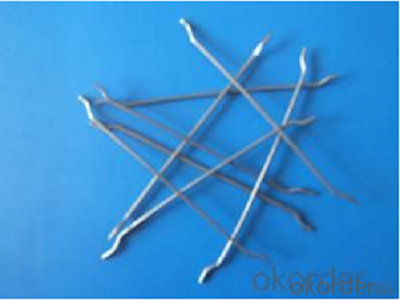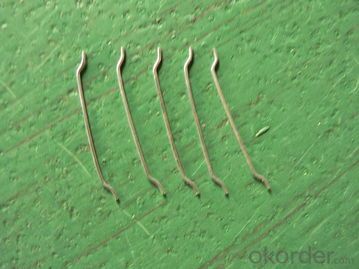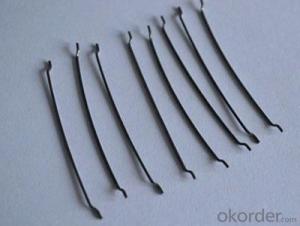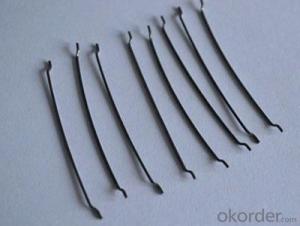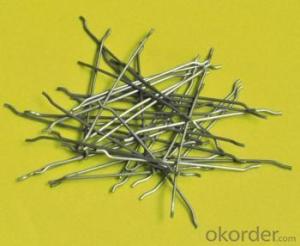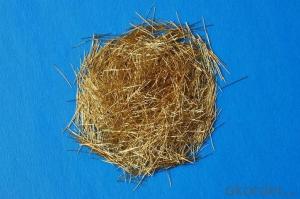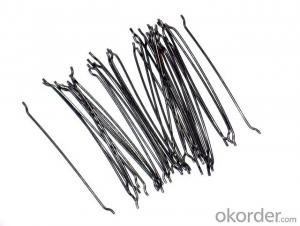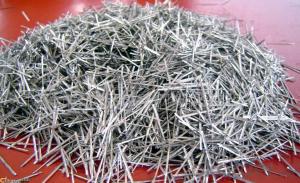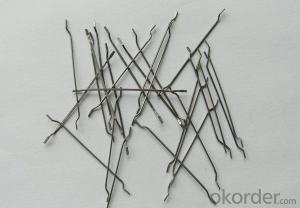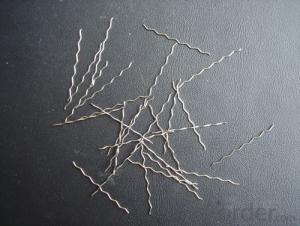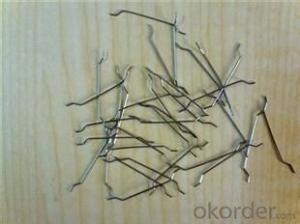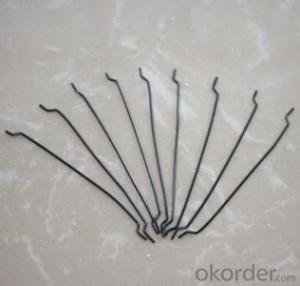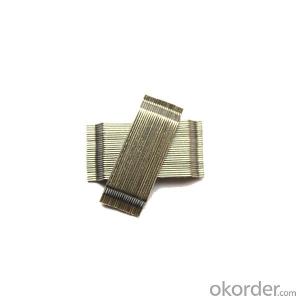Melt Extract Stainless Steel Fiber Reinforced Concrete Steel Fiber 0.9/55 from CNBM China
- Loading Port:
- Tianjin
- Payment Terms:
- TT or LC
- Min Order Qty:
- 1 m.t.
- Supply Capability:
- 5000 m.t./month
OKorder Service Pledge
OKorder Financial Service
You Might Also Like
Quick Details
Place of Origin: Tianjin, China (Mainland)
Model Number: 0.9
Material: Steel
Production Process: Cold drawn
Lengh: 55
Type: 1
Compressive Strength: >1200MPa
Aspect ratio: 61
Standard: ASTM A820M-11
Section Shape: Circular
Application: Concrete Reinforcement
Specifications
| Diameter | 0.90 | mm | 0.04 | in |
| Length | 55.00 | mm | 2.16 | in |
| Aspect Ratio | 61 | |||
| Tensile strength | 1200 MPa | |||
| Type | Cold drawn Steel Fiber | |||
| End | Hooked-end Steel Fiber | |||
| Glued/Loose | Glued Steel Fiber | |||
| Bending Angle | 45°(min.30°) | |||
| Usage & Performance | Floor:Trafficked areas and Industrial floors | |||
| Shotcrete :Slope stabilization and Final lining | ||||
| Precast concrete:Pipe and Railway sleepers | ||||
| Packing | Standard Export Pallet Packing | Bag Packing | 20 kg/Bag,50 bags/Pallet | |
| Bulk Packing | 1,000kg/ Bulk Bag | |||
| Loading Quantity | 20’GP | 20-25 Tonne/Tonnes | ||
| 40’GP | 25-27 Tonne/Tonnes | |||
| 40’HQ | 25-27 Tonne/Tonnes | |||
| MOQ | 1 kg for trial order | |||
| Supply Ability | 10,000 Tonne/Tonnes per Year | |||
| Payment Terms | T/T or L/C at sight | |||
| Delivery Time | Within 15 days after receiving deposit or original L/C at sight | |||
| Certification | ISO9001:2000, CE, | |||
| Product | Diameter | Length mm/in | Aspect Ratio | Type | Packing |
| G-6030 | 0.5 mm (0.0197 in) | 30 mm (1.1811 in) | 60 | Glued | 20 kg/Bag, or 1,000kg/ Bulk Bag |
| G-6535 | 0.55 mm (0.0217 in) | 35 mm (1.3780 in) | 65 | Glued | 20 kg/Bag, or 1,000kg/ Bulk Bag |
| G-6035 | 0.6 mm (0.0236 in) | 35 mm (1.3780 in) | 60 | Glued | 20 kg/Bag, or 1,000kg/ Bulk Bag |
| G-8060 | 0.75 mm (0.0295 in) | 60 mm (2.3622 in) | 80 | Glued | 20 kg/Bag, 50 bags/Pallet |
| G-6060 | 0.9 mm (0.0354 in) | 60 mm (2.3622 in) | 60 | Glued | 20 kg/Bag, 50 bags/Pallet |
| G-6030 | 0.5 mm (0.0197 in) | 30 mm (1.1811 in) | 60 | Loose | 20 kg/Bag, or 1,000kg/ Bulk Bag |
| G-6535 | 0.55 mm (0.0217 in) | 35 mm (1.3780 in) | 65 | Loose | 20 kg/Bag, or 1,000kg/ Bulk Bag |
| G-6035 | 0.6 mm (0.0236 in) | 35 mm (1.3780 in) | 60 | Loose | 20 kg/Bag, or 1,000kg/ Bulk Bag |
| G-8060 | 0.75 mm (0.0295 in) | 60 mm (2.3622 in) | 80 | Loose | 20 kg/Bag, 50 bags/Pallet |
| G-6060 | 0.9 mm (0.0354 in) | 60 mm (2.3622 in) | 60 | Loose | 20 kg/Bag, 50 bags/Pallet |
Picture
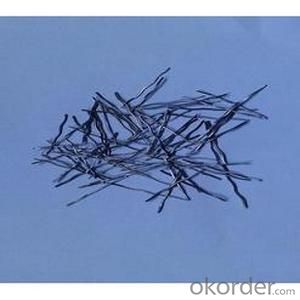
Steel fiber
FAQ
Technical advantages of Daye steel fiber:
A. Improve mechanical performance of concrete
B. Provide uniform distribution throughout concrete with excellent mixing
C. No balling or caking by adopt correct mixing method
D. Reduce concrete volume
E.Save construction time and cost
F.Reduce excavation volume
G.Available for jointless floor.
- Q: What is the average length of melt extract stainless steel fiber?
- The specific application and manufacturing process often determine the average length of melt extract stainless steel fiber. Generally, this fiber ranges from a few millimeters to a few centimeters, which is ideal for improving the mechanical properties and durability of materials like concrete, composites, and refractories. It is important to mention that manufacturers can provide various lengths of melt extract stainless steel fiber to meet the specific requirements and preferences of their customers.
- Q: Can melt extract stainless steel fiber be used in roller-compacted concrete (RCC)?
- Yes, melt extract stainless steel fiber can be used in roller-compacted concrete (RCC). RCC is a type of concrete that is compacted using rollers, which provides a denser and more durable finished product. The addition of stainless steel fibers in RCC can enhance its mechanical properties, such as resistance to cracking and improved flexural strength. Melt extract stainless steel fibers are produced by melting stainless steel and then rapidly extracting it into fine fibers. These fibers have high tensile strength, corrosion resistance, and can effectively distribute stresses within the concrete matrix. As a result, they can enhance the performance of RCC by improving its resistance to shrinkage, impact, and fatigue. Furthermore, melt extract stainless steel fibers are easily dispersed in the concrete mixture and can be evenly distributed throughout the RCC during the compaction process. This ensures that the fibers are well-bonded with the concrete matrix, providing uniform reinforcement and preventing the formation of cracks. In summary, the use of melt extract stainless steel fiber in roller-compacted concrete is a suitable option to enhance its mechanical properties and overall durability. However, it is important to consult with concrete experts and conduct proper testing to determine the appropriate dosage and fiber length for the specific RCC application.
- Q: Can melt extract stainless steel fiber be used in tunnel lining rehabilitation applications?
- Yes, melt extract stainless steel fiber can be used in tunnel lining rehabilitation applications.
- Q: Can melt extract stainless steel fiber be used in high-performance or self-compacting concrete?
- Yes, melt extract stainless steel fiber can be used in high-performance or self-compacting concrete. It enhances the mechanical properties of concrete, such as its strength, durability, and ductility. The addition of stainless steel fibers improves the crack resistance and flexural strength of the concrete, making it suitable for high-performance and self-compacting applications.
- Q: What is the effect of melt extract stainless steel fiber on the plastic settlement of shotcrete?
- The melt extract stainless steel fiber has a positive effect on the plastic settlement of shotcrete. It helps to improve the overall stability and reduce the plastic shrinkage cracking by reinforcing the concrete matrix. The fibers act as a reinforcement, enhancing the tensile strength and reducing the settlement and cracking of the shotcrete during the plastic phase.
- Q: Can melt extract stainless steel fiber be used in parking lot pavements?
- Yes, melt extract stainless steel fiber can be used in parking lot pavements. It is often added to concrete mixtures to enhance the strength and durability of the pavement, making it more resistant to cracking and wear. The stainless steel fiber reinforcement helps to increase the lifespan of the parking lot and reduce maintenance requirements.
- Q: Can melt extract stainless steel fiber be used in industrial flooring applications?
- Yes, melt extract stainless steel fiber can be used in industrial flooring applications. It provides additional reinforcement and durability to the flooring, making it suitable for heavy-duty industrial environments.
- Q: Can melt extract stainless steel fiber reduce the risk of early-age cracking in concrete?
- Yes, melt extract stainless steel fiber can reduce the risk of early-age cracking in concrete. Early-age cracking in concrete is commonly caused by shrinkage, temperature changes, and lack of adequate tensile strength. By adding melt extract stainless steel fibers to the concrete mix, the overall tensile strength of the concrete is increased. These fibers act as reinforcement, effectively distributing stresses and preventing crack initiation and propagation. Additionally, the stainless steel fibers help to control the shrinkage of concrete by reducing the width and length of cracks that may occur. This reduces the risk of early-age cracking and improves the durability and longevity of the concrete structure.
- Q: How does melt extract stainless steel fiber improve the fire resistance of concrete?
- Melt extract stainless steel fiber improves the fire resistance of concrete by acting as a reinforcement material. When the concrete is exposed to high temperatures during a fire, the stainless steel fiber helps to enhance the structural integrity of the concrete by providing additional strength and stability. The stainless steel fiber is able to withstand high temperatures without melting or losing its mechanical properties. This allows it to effectively distribute the stress and load within the concrete, preventing cracks and fractures that could compromise the structural integrity of the material. Furthermore, the presence of stainless steel fiber in the concrete helps to delay the onset of spalling. Spalling is a phenomenon in which the surface layers of concrete break apart and detach due to the rapid expansion of the moisture trapped within the material when exposed to high temperatures. By reinforcing the concrete, the stainless steel fiber helps to retain the moisture and prevent its rapid release, thereby reducing the risk of spalling. In addition to its reinforcing properties, the stainless steel fiber also acts as a heat sink. This means that it absorbs and dissipates heat more efficiently than the surrounding concrete, which helps to reduce the overall temperature rise of the material during a fire. By reducing the temperature rise, the stainless steel fiber can minimize thermal expansion and contraction, reducing the likelihood of cracks and maintaining the structural integrity of the concrete. Overall, the incorporation of melt extract stainless steel fiber in concrete significantly improves its fire resistance by enhancing its structural strength, reducing spalling, and minimizing temperature rise. This makes it an effective solution for increasing the fire safety of concrete structures in various applications, such as buildings, tunnels, and industrial facilities.
- Q: Can melt extract stainless steel fiber be used in seismic-resistant concrete applications?
- Yes, melt extract stainless steel fiber can be used in seismic-resistant concrete applications. Stainless steel fibers are known for their high tensile strength and excellent corrosion resistance, making them ideal for reinforcing concrete structures in earthquake-prone areas. These fibers enhance the overall ductility and toughness of the concrete, improving its ability to withstand seismic forces and reduce crack propagation.
Send your message to us
Melt Extract Stainless Steel Fiber Reinforced Concrete Steel Fiber 0.9/55 from CNBM China
- Loading Port:
- Tianjin
- Payment Terms:
- TT or LC
- Min Order Qty:
- 1 m.t.
- Supply Capability:
- 5000 m.t./month
OKorder Service Pledge
OKorder Financial Service
Similar products
Hot products
Hot Searches
Related keywords


